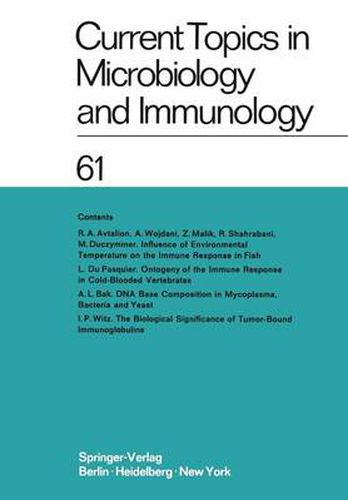Readings Newsletter
Become a Readings Member to make your shopping experience even easier.
Sign in or sign up for free!
You’re not far away from qualifying for FREE standard shipping within Australia
You’ve qualified for FREE standard shipping within Australia
The cart is loading…






This title is printed to order. This book may have been self-published. If so, we cannot guarantee the quality of the content. In the main most books will have gone through the editing process however some may not. We therefore suggest that you be aware of this before ordering this book. If in doubt check either the author or publisher’s details as we are unable to accept any returns unless they are faulty. Please contact us if you have any questions.
At the end of the last century and the beginning of this century, the prob lems of immunity in lower vertebrates and the influence of environmental temperature attracted attention for the first time (ERNST, 1890; WIDAL and SICARD, 1897; METCHNIKOFF, 1901). However, relatively little work has been done on this subject until recently. The early investigators were chiefly in terested in the immuno-pathological problems. They immunized various species of lower vertebrates essentially with bacterial vaccines; agglutinating, neutralizing and protective antibodies were detected in their blood. The in fluence of environmental temperature on the immune response was investigated, since this subject represented great economical and theoretical importance. Epizootic diseases were observed to occur in relation to the cold season of the year, when the decrease or spontaneous increase of water temperature occurred (SCHAPERCLAUS, 1965; BESSE et al. , 1965; KLONTZ et al. , 1965 WOOD,1966). The immunological deficiency of fish, caused by their natural or experimental stay in cold water, is now evident for both humoral and cellular immunity. In this review we will focus on two points: We shall attempt (1) to explain the mechanism by which the environmental temperature influences the immune resistance of fish to pathogens, (2) to determine the chronological location of this temperature-sensitive stage in the process of antibody formation, and to make some approaches to the general antibody formation mechanism.
$9.00 standard shipping within Australia
FREE standard shipping within Australia for orders over $100.00
Express & International shipping calculated at checkout
This title is printed to order. This book may have been self-published. If so, we cannot guarantee the quality of the content. In the main most books will have gone through the editing process however some may not. We therefore suggest that you be aware of this before ordering this book. If in doubt check either the author or publisher’s details as we are unable to accept any returns unless they are faulty. Please contact us if you have any questions.
At the end of the last century and the beginning of this century, the prob lems of immunity in lower vertebrates and the influence of environmental temperature attracted attention for the first time (ERNST, 1890; WIDAL and SICARD, 1897; METCHNIKOFF, 1901). However, relatively little work has been done on this subject until recently. The early investigators were chiefly in terested in the immuno-pathological problems. They immunized various species of lower vertebrates essentially with bacterial vaccines; agglutinating, neutralizing and protective antibodies were detected in their blood. The in fluence of environmental temperature on the immune response was investigated, since this subject represented great economical and theoretical importance. Epizootic diseases were observed to occur in relation to the cold season of the year, when the decrease or spontaneous increase of water temperature occurred (SCHAPERCLAUS, 1965; BESSE et al. , 1965; KLONTZ et al. , 1965 WOOD,1966). The immunological deficiency of fish, caused by their natural or experimental stay in cold water, is now evident for both humoral and cellular immunity. In this review we will focus on two points: We shall attempt (1) to explain the mechanism by which the environmental temperature influences the immune resistance of fish to pathogens, (2) to determine the chronological location of this temperature-sensitive stage in the process of antibody formation, and to make some approaches to the general antibody formation mechanism.